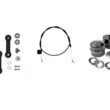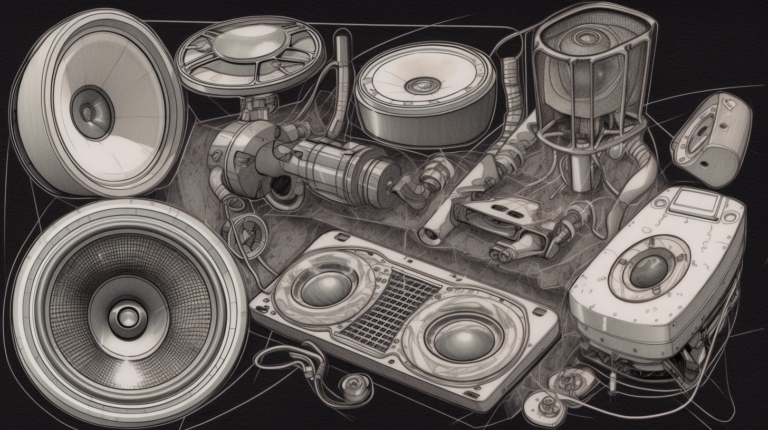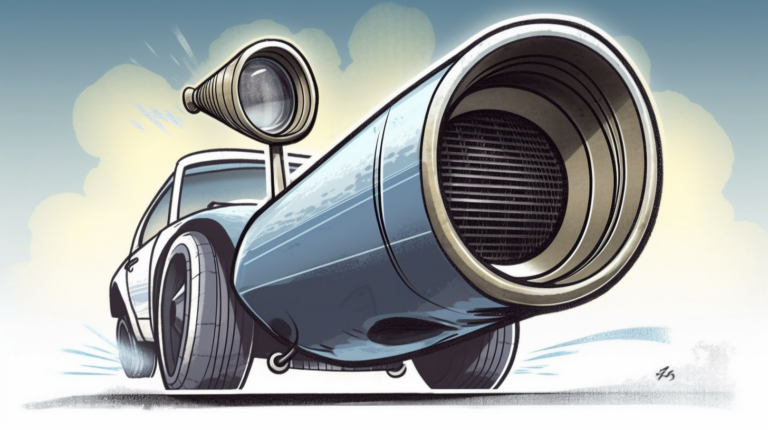Components Of A Car Audio System
Building the perfect car audio system can be daunting. But with a little know-how, you’ll have your dream setup in no time! To get started, you’ll need to understand what components are essential for any great car stereo system. The most important component of a car audio system is the head unit – this houses all the controls and electronics that make up your sound. From there, you’ll want to add some speakers so you can actually hear music coming out of your vehicle. There are many sizes and designs available on the market, but generally speaking it’s best to go with something small enough to fit within the confines of your vehicle yet powerful enough to produce quality sound. Finally, don’t forget about subwoofers and amplifiers if you’re looking to really boost your bass or achieve surround sound effects. Subwoofers will help fill out the low end frequencies while an amplifier ensures each speaker gets the power it needs for optimal performance. With these key components, you’ll be well on your way towards creating an awesome car stereo system!Choosing The Right Speakers
When it comes to choosing the right speakers, there are several types of aftermarket speakers available. Component speakers have a separate woofer and tweeter that can be mounted in different places throughout your vehicle for better sound quality. Full-range speakers come in various sizes and offer both low and high frequencies from one unit. Lastly, mid-range speakers provide powerful mids but lack on the upper range frequencies. The size of the speaker is also important when selecting which type is best for you. You want to make sure it fits where you plan to install it so measure accordingly before making any purchases. Additionally, consider what power capabilities the speaker has and how much wattage output your receiver will give off as this affects performance too. Finally, look at other features like sensitivity rating since this determines how efficiently they convert amplifier power into loudness without distortion or harshness. By taking all these factors into consideration you can pick out the perfect set of car audio speakers for your system!Amplifiers And Power Supplies
When building the perfect car audio system, amplifiers and power supplies are essential. An amplifier is a key part of any sound system as it increases the signal strength from an audio source, resulting in improved sound quality. A powerful amplifier helps create loud and clear sounds that will keep you entertained while driving. Powering your car’s audio system can be tricky since there are many different types of power supplies available for purchase. It is important to select one that works with your specific type of car amplifier otherwise the sound quality won’t be up to standard. Each vehicle requires its own set of power supply needs so make sure to do research before making a selection. The best way to ensure great sound quality when constructing an audio system for your vehicle is by investing in high-quality components such as amplifiers and power supplies. With these two components working together, you’ll have all the bass and treble levels needed for smooth listening experiences that will last for years to come!Subwoofers And Sub-Enclosures
Now that we’ve discussed amplifiers and power supplies, it’s time to move on to subwoofers and sub-enclosures. Subwoofers are a crucial part of any car audio system; they provide the low-end bass frequencies necessary for great sound reproduction. Here are three tips to help you build the perfect setup:- Utilize sound deadening materials around your sub-enclosure. This will reduce unwanted road noise and vibrations, ensuring maximum performance from your speakers.
- Choose an aftermarket stereo with preamp outputs specifically designed for powering subwoofers. This will make sure that each component in your car audio system is getting adequate power.
- Upgrade your speaker wires! High quality wiring ensures reliable connections between components, resulting in greater clarity and enhanced sound reproduction.
Sound Processors And Equalizers
Like a conductor orchestrating a symphony, sound processors and equalizers bring all the audio signals of your car stereo together to create beautiful music. They are like the maestro in charge of making sure everything goes according to plan. By using these components you can build a car audio system that is tailored specifically for your vehicle’s acoustics and will ensure each note sounds perfect as it moves from speaker to listener. When selecting the best sound processor or equalizer for your setup, consider its specifications such as frequency response range, bandwidth, noise floor, dynamic range, digital-to-analog converter (DAC) resolution and crossovers – just to name a few! With this information at hand you’ll be able to make an informed decision about which component is right for you. To help simplify things here’s a table that breaks down some popular choices:| Processor/Equaliser | Frequency Response Range | Bandwidth | Noise Floor |
|---|---|---|---|
| Alpine | 10 Hz – 20 kHz | 30 dB | >110dB |
| Pioneer | 20Hz–20kHz | 40 dB | <100dB |
| JBL | 5Hz–50kHz | 50 dB | <120dB |
In-Dash Receivers And Head Units
In-dash receivers and head units are the brains behind any car audio system. They come in many styles, from basic to high end models. If you’re looking for a factory head unit with all the bells and whistles, there’s Mark Levinson or Pioneer Elite systems that offer excellent sound quality. For those who want more than what their factory model offers, aftermarket options like Eclipse or Kenwood can provide an upgrade in features. The first step when installing a new receiver is choosing the right one for your vehicle. It should fit snugly into the dash of your car and have enough power to drive your speakers properly. You’ll also need to consider if you want additional features such as DVD players, satellite radio, navigation systems or Bluetooth connectivity. Once you’ve selected your perfect model, it’s time to install it! Car stereo installation doesn’t have to be difficult; some people prefer to do it themselves while others opt for professional help. Either way, proper wiring and secure mounting will ensure good sound quality throughout your journey. With just a few steps, you’ll soon be enjoying crisp music from your brand new car audio system!Tuning Your Audio System For Optimal Sound Quality
Setting up your car’s audio system can be a thrilling experience! You get to choose the speakers, sound quality and other features that will fit perfectly into your vehicle. To make sure that you get the most out of your audio system, tuning it properly is essential. Here are some tips for tuning your car audio setup for optimal sound quality:- Identify which type of system best suits your situation – such as Android Auto or apple car play.
- Consider upgrading any outdated components, like old car speakers to ensure great sound.
- Make sure all wires and connections are secure– don’t underestimate this step!
- Run audio calibration tests in order to tailor the settings specifically for your vehicle.
Installation Tips For Beginners
Installing a car audio system can be daunting for beginners, but with careful planning and some basic knowledge anyone can get the job done. The first step is to figure out what kind of components you need. You may want to start with a factory stereo or go all out with a remote start and coaxial speakers. Next, decide where you’re going to mount your equipment so that it looks good and functions properly. In order to connect everything together, you’ll need wiring harnesses that fit your vehicle as well as any aftermarket parts. This will allow you to plug in each component without having to cut into wires. Once you have all the pieces connected, test them out one by one before mounting anything permanently. Make sure the sound from your rear speakers is balanced with the front ones and adjust accordingly if needed. To complete your installation project, hide away any excess wires using cable ties or other securing materials then check for loose connections between components. Finally, don’t forget to double-check your work! Installing an audio system requires patience and attention to detail but when finished correctly it will provide years of enjoyable listening experiences on the road ahead.Advanced Installation Techniques
Advanced installation techniques can turn an average car sound system into one that will blow away any road noise. It’s a great way for car owners to get the very best performance from their audio systems.| Table: Installation Techniques | Benefits of Technique | Challenges of Technique |
|---|---|---|
| GPS navigation | Easier to find destinations; better route guidance | Costly if not already included with vehicle |
| Adding subwoofers | Brings out bass tones in music; increases overall volume | Can overpower other speakers and create distorted sounds |
| Installing custom amplifiers | Increased control over listening experience; improved sound quality | Difficult to install properly without professional help |
Tips For Troubleshooting Common Issues
As you continue to build your car audio system, it’s important to remember that troubleshooting any potential issues is key. You can use the tips below to help diagnose and solve common problems with cars’ audio systems. Make sure all connections are secure. Any loose wires or cable connectors could be causing interference in your audio system. Check both the back of your stereo receiver and the cables running throughout your vehicle for tightness and security. Test out different settings on your car’s audio system. Adjusting things like volume, treble, bass and other sound effects may make a big difference in how good your sound quality is. Try experimenting with these settings until you find one that works best for you before moving onto something else. Consult your car manufacturer’s manual for more specific information about the type of equipment included in the manufacture of their vehicles’ audio systems. Knowing exactly what kind of setup you have will give you an advantage when trying to identify possible sources of trouble with better accuracy . Many times, simply cleaning dirty parts such as speaker cones or dust-covered receivers can greatly improve sound quality too! If none of the above steps seem to fix whatever issue might arise, try wiping down all accessible components with a slightly damp cloth to see if this helps clear up any static noise or distortion coming from speakers or headphones connected to your car’s audio system. Troubleshooting problems can take some time and effort but if done correctly, it can result in much better sound performance from your car’s audio system overall! Keep tinkering around until you achieve optimal results — then hit the open road and enjoy the ride!Understanding Digital Signal Processing (Dsp)
Digital Signal Processing (DSP) is an incredible tool that can give your car audio system an amazing sound. It’s a type of processor used to improve the quality of sound in any audio system, from home stereo systems to full-on vehicle sound systems. DSP gives you access to features like equalization, time alignment, and signal shaping that help create great sounding music. The following table outlines key advantages of using DSP:| Pros | Cons |
|---|---|
| Incredible Sound Quality | Potentially Complex Setup & Tuning Process |
| Increased Control Over Your Audio System | Expense for Additional Equipment & Software |
| Ability To Customize Your System For Your Vehicle & Listening Preferences | Potential Interference With Other Electronics In The Car |
Benefits Of Installing A Car Audio System
Now that you know the basics of digital signal processing, it’s time to look at the benefits of installing a car audio system. With today’s technology, a great-sounding system can be put together for an affordable price. You don’t have to spend a fortune on components either; most systems are fairly easy and inexpensive to install. First, having a good sound system in your car will make your driving experience much more enjoyable. The bass from well-placed subwoofers adds richness and depth to music so you can really feel the notes and rhythms while cruising down the highway. Plus, with high quality speakers, you’ll hear every nuance of each song without distortion or noise interference. Second, having a nice stereo is safer too! You won’t need to turn up the volume as loud just to drown out outside noises like wind or traffic, allowing you to keep better focus on the road ahead. It also means no more distractions behind the wheel—you’ll never miss important phone calls or messages because they’ll come through crystal clear. And if there ever is an emergency situation, you’ll be able to hear instructions easily over your speakers instead of straining against background noise. Finally, investing in a car audio system is one of those rare purchases that keeps giving back long after it’s installed. Not only will its superior sound improve any drive but the pleasure it brings should last for years with proper maintenance and upkeep. Whether you want smooth jazz on Saturday nights or thumping hip hop during rush hour commutes – nothing beats having a personal soundtrack tailored perfectly for every journey!Safety Precautions To Consider During Installation
Safety should always come first when installing a car audio system. Taking the proper precautions is necessary to ensure that everything runs smoothly and without any mishaps. Here are some tips to keep in mind while setting up your new sound system. First, it’s important to start with the basics: make sure all of the wires are safely connected before plugging anything into an outlet or battery terminal. It’s also a good idea to double check each connection before you turn on the power sources. This will help reduce the risk of electrical shorts or other potential hazards. Next, be mindful of where you place your speakers and amplifier components. You want them placed securely so they don’t become loose during operation. If something becomes dislodged while driving, it could potentially cause damage to both your vehicle and yourself. Additionally, be careful not to overheat or overload any components as this can result in fire or explosion risks depending on what type of materials were used for construction. Finally, pay attention to how much power your system is drawing from your battery source – too much draw could lead to draining issues which may require replacing parts if left unchecked for too long. Make sure all wiring is properly grounded and insulated, especially near areas prone to moisture buildup like under the dash or near windowsills – these extra steps can go a long way towards avoiding costly problems down the line! With these safety reminders taken care of, you’re ready to get started building the perfect car audio system!Why are Car Tweeters an Essential Component for a Perfect Car Audio System?
Car tweeters are an essential component to upgrade car audio systems. These small speakers produce high-frequency sounds and enhance the overall sound quality, making the music more crisp and clear. By incorporating car tweeters, you can achieve a perfect audio experience in your car, immersing yourself in the music like never before.
Identifying Quality Parts And Accessories
Building the perfect car audio system is like constructing a dream home. It needs to be strong, reliable and have good sound quality. To get this right, you need quality parts with features that meet your specific needs. Here are three tips for finding these: Check Reviews – Before making any purchase decisions, read user reviews on different websites or forums about the products you’re considering. This way, you can learn from other people’s experiences and determine which product is best suited for your setup. Ask Questions – Don’t be afraid to ask questions in stores when looking at components and accessories. Employees may not always know every technical detail of each item, but they should still be able to provide helpful advice based on their experience with similar items. Measure Performance – Even if a part looks great and has an impressive price tag, it’s important to remember that performance matters more than anything else. Test out the item before committing to a purchase so you can ensure it will work well in your system and won’t require extra tweaks or replacements down the road. Making sure all of your components are top-notch will guarantee years of enjoyment while cruising around town listening to music! So take time researching what works best for your setup; it’ll go a long way towards creating the perfect car audio system!Maintaining Your Car Audio System
Maintaining your car audio system is important for keeping it running smoothly. Here are some tips to keep in mind:| Check | Frequency |
|---|---|
| Wiring and Connections | Every 6 Months |
| Amplifier Voltage Output | Once a Year |
| Speaker Performance | Twice a Year |
| Bass Responses | Monthly |





















